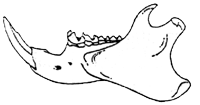Marmot
 Anyone
traveling through southern Idaho has seen them by the side of the road, or often,
running across the road playing "chicken" with your car. They are
the largest living member of the squirrel family and are known locally as rockchucks,
a western relative of the well known woodchuck or ground hog, who gets national
attention every February 2. The rockchuck or yellow bellied marmot, Marmota
flaviventris, is found throughout the western United States and can be found
in a variety of environments from desert to mountain.
Anyone
traveling through southern Idaho has seen them by the side of the road, or often,
running across the road playing "chicken" with your car. They are
the largest living member of the squirrel family and are known locally as rockchucks,
a western relative of the well known woodchuck or ground hog, who gets national
attention every February 2. The rockchuck or yellow bellied marmot, Marmota
flaviventris, is found throughout the western United States and can be found
in a variety of environments from desert to mountain.
Many visitors to the area are amazed by the size of the
largest of all the ground squirrels, 3.9 kilograms (8.5 pounds) on the average although
some individuals will get as large as 5.2 kg (11.5 pounds). Had people been visiting
Hagerman Fossil Beds 3.5 million years ago they would have been even more amazed at the
size of the fossil marmot, Paenemarmota barbouri, found here. It was roughly twice
the size of our living yellow-bellied marmot.
 The
giant marmot was first described in 1948 based on a specimen found in Kansas.
During the Pliocene, it was widely distributed in western North America and
has also been found in Nebraska, Texas, Arizona and northern Mexico. It was
not reported from Hagerman until 1969. The Hagerman record is currently the
most northern and western record for the animal.
The
giant marmot was first described in 1948 based on a specimen found in Kansas.
During the Pliocene, it was widely distributed in western North America and
has also been found in Nebraska, Texas, Arizona and northern Mexico. It was
not reported from Hagerman until 1969. The Hagerman record is currently the
most northern and western record for the animal.
Most of the skeleton of Paenemarmota is unknown and
just about all records of the animal are based on lower jaws and a few palates and partial
skulls. There are probably lots of bones of Paenemarmota in museum collections, but
they have not been recognized. It's not surprising since teeth, skulls and jaws are the
most distinctive part of an animal and are the easiest to identify. After an animal dies,
unless it is buried quickly, the bones will become separated and scattered once the
muscles and ligaments decay. Unless the bones of the skeleton are associated with the
skull or jaw a paleontologist might not be absolutely sure that they belong to the same
type of animal. This is not a problem unique to Paenemarmota, but to all fossil
vertebrates. Unless there is a complete skeleton found, it is difficult for a
paleontologist to determine which bones belong together. Often in some cases the bones of
different types of animals might be mixed together, or different names may be given to the
same animal based on different parts of the skeleton. Both of these problems have happened
in the past but as new and more complete specimens are found, paleontologists are
constantly updating our understanding of each species. So who knows, there are probably
lots of bones of this animal squirreled away in museum collections, just waiting to be
recognized.
 Anyone
traveling through southern Idaho has seen them by the side of the road, or often,
running across the road playing "chicken" with your car. They are
the largest living member of the squirrel family and are known locally as rockchucks,
a western relative of the well known woodchuck or ground hog, who gets national
attention every February 2. The rockchuck or yellow bellied marmot, Marmota
flaviventris, is found throughout the western United States and can be found
in a variety of environments from desert to mountain.
Anyone
traveling through southern Idaho has seen them by the side of the road, or often,
running across the road playing "chicken" with your car. They are
the largest living member of the squirrel family and are known locally as rockchucks,
a western relative of the well known woodchuck or ground hog, who gets national
attention every February 2. The rockchuck or yellow bellied marmot, Marmota
flaviventris, is found throughout the western United States and can be found
in a variety of environments from desert to mountain.  The
giant marmot was first described in 1948 based on a specimen found in Kansas.
During the Pliocene, it was widely distributed in western North America and
has also been found in Nebraska, Texas, Arizona and northern Mexico. It was
not reported from Hagerman until 1969. The Hagerman record is currently the
most northern and western record for the animal.
The
giant marmot was first described in 1948 based on a specimen found in Kansas.
During the Pliocene, it was widely distributed in western North America and
has also been found in Nebraska, Texas, Arizona and northern Mexico. It was
not reported from Hagerman until 1969. The Hagerman record is currently the
most northern and western record for the animal.